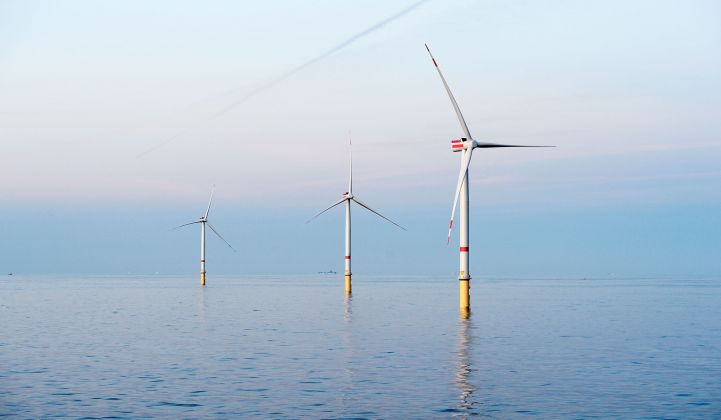A partnership between developer Bay State Wind and NEC Energy Solutions this month highlighted a growing push to pair energy storage with offshore wind.
Bay State Wind said it will work with NEC Energy Solutions to add batteries to an 800-megawatt offshore wind farm planned for 15 miles off the coast of Martha’s Vineyard, Massachusetts.
The project will represent the world’s largest wind‐paired energy storage system for commercial‐scale energy, said Bay State Wind, which is a joint partnership between the Danish power company Ørsted, formerly known as Dong, and U.S. transmission builder Eversource.
This month, Bay State Wind qualified for Title 41 of the Fixing America’s Surface Transportation Act (FAST-41), making it the first and only offshore wind project, and one of only 38 infrastructure projects in the U.S., to receive FAST-41 status.
NEC will add 55 megawatts and 110 megawatt-hours of storage to the wind farm “to help the region in overcoming winter reliability challenges by delivering energy when it is needed most and help to reduce winter peak energy prices and price volatility,” Bay State Wind said.
The developer highlighted the deal’s potential to create new jobs, since NEC Energy Solutions was born from the ashes of A123, a Massachusetts-based company.
Bay State Wind also said the offshore wind and energy storage combination would help cut winter electricity prices in Massachusetts by approximately $158 million a year, as well as enhance grid stability by shifting energy delivery to better meet demand.
“The development of a robust battery storage system will help small businesses and consumers by ensuring a steady supply of energy, thereby reducing high‐demand energy spikes,” said Mike Auseré, Eversource’s vice president of business development.
With offshore wind developers looking to cut costs as quickly as possible, the decision to add extra expense to a project, in the form of batteries, might seem an odd one.
But Michael Guldbrandsten, a former analyst with MAKE Consulting, said the combination might actually improve offshore wind economics.
NEC’s involvement with Bay State Wind “will be crucial to reduce costs associated with balancing demand and supply of power,” he said. “Initiatives like this will become increasingly relevant for integration of offshore wind.”
Last year, he noted, Ørsted moved to install a 2-megawatt power battery at one of its U.K. offshore projects, the 90-megawatt Burbo Bank wind farm, to provide frequency regulation services.
“Though the battery size was relatively small, it was a clear and early sign of developers starting to contribute actively to ensuring the balancing of the entire system,” Guldbrandsten said.
“With Ørsted’s decision to incorporate battery storage alongside its 800-megawatt Bay State Wind project, the company is taking another key step in terms of increasing the potential for offshore wind development.”
The Burbo Bank project is thought to have been the first example of batteries being added to offshore wind. But other developers are planning offshore wind storage options, too.
This year, for example, the German energy storage system developer Younicos, now owned by power rental company Aggreko, is due to add a 1-megawatt/1.3-megawatt-hour battery system to Statoil’s 30-megawatt Hywind project, the world’s first floating wind farm.
“The purpose of the Batwind storage solution project is to understand how a battery can help increase the value of the produced electricity and how a battery can best work together with the wind farm and the grid,” said Statoil in a press release last November.
And last August, U.S. offshore developer Deepwater Wind announced plans to add 40 megawatts of Tesla battery storage to its proposed 144-megawatt Revolution Wind project off the Massachusetts coast. Lawmakers have yet to approve the wind farm proposal.
These moves come amid growing interest in adding energy storage to wind.
As reported in GTM, Danish wind systems developer KK Wind Solutions is working with manufacturer Vestas and other industry players to cut turbine power output fluctuations by 90 percent through the addition of batteries to the machines. Acciona is also looking at adding batteries to turbines. And Siemens Gamesa, which is expected to take on Vestas as the world’s largest turbine manufacturer by 2020, is aiming to combine thermal storage with wind power.




